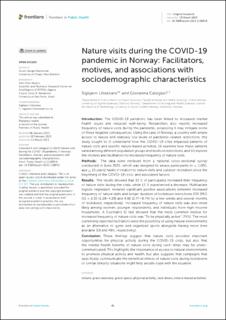| dc.contributor.author | Litleskare, Sigbjørn | |
| dc.contributor.author | Calogiuri, Giovanna | |
| dc.date.accessioned | 2023-10-20T07:41:50Z | |
| dc.date.available | 2023-10-20T07:41:50Z | |
| dc.date.created | 2023-03-13T15:30:01Z | |
| dc.date.issued | 2023 | |
| dc.identifier.issn | 2296-2565 | |
| dc.identifier.uri | https://hdl.handle.net/11250/3097716 | |
| dc.description.abstract | Introduction: The COVID-19 pandemic has been linked to increased mental health issues and reduced well-being. Researchers also reports increased frequency of nature visits during the pandemic, proposing it may mitigate some of these negative consequences. Using the case of Norway, a country with ample access to nature and relatively low levels of pandemic-related restrictions, this study sought to (i) understand how the COVID-19 crisis impacted patterns of nature visits and specific nature-based activities, (ii) examine how these patterns varied among dierent population groups and levels of restrictions, and (iii) explore the motives and facilitators for increased frequency of nature visits. Methods: The data were retrieved from a national cross-sectional survey conducted in June 2021, which was designed to assess participants (n = 1,005, age > 15 years) habits in relation to nature visits and outdoor recreation since the beginning of the COVID-19 crisis, and associated factors. Results: The results showed that 32 % of participants increased their frequency of nature visits during the crisis, while 11 % experienced a decrease. Multivariate logistic regression revealed significant positive associations between increased frequency of nature visits and longer duration of lockdown restrictions (OR [95% CI] = 2.35 [1.28–4.29] and 4.92 [2.77–8.74] for a few weeks and several months of lockdown, respectively). Increased frequency of nature visits was also more likely among women, younger respondents, and individuals from high-income households. A Cochran’s Q test showed that the most common motive for increased frequency of nature visits was “To be physically active” (74%). The most commonly reported facilitators were the possibility of using natural environments as an alternative to gyms and organized sports alongside having more time available (58 and 49%, respectively). Conclusion: These findings suggest that nature visits provided important opportunities for physical activity during the COVID-19 crisis, but also that the mental health benefits of nature visits during such times may be undercommunicated. This highlights the importance of access to natural environments to promote physical activity and health, but also suggests that campaigns that specifically communicate the beneficial eects of nature visits during lockdowns or similar stressful situations might help people cope with the situation. | en_US |
| dc.language.iso | eng | en_US |
| dc.rights | Navngivelse 4.0 Internasjonal | * |
| dc.rights.uri | http://creativecommons.org/licenses/by/4.0/deed.no | * |
| dc.title | Nature visits during the COVID-19 pandemic in Norway: Facilitators, motives, and associations with sociodemographic characteristics | en_US |
| dc.title.alternative | Nature visits during the COVID-19 pandemic in Norway: Facilitators, motives, and associations with sociodemographic characteristics | en_US |
| dc.type | Peer reviewed | en_US |
| dc.type | Journal article | en_US |
| dc.description.version | publishedVersion | en_US |
| dc.source.journal | Frontiers in Public Health | en_US |
| dc.identifier.doi | 10.3389/fpubh.2023.1138915 | |
| dc.identifier.cristin | 2133567 | |
| cristin.ispublished | true | |
| cristin.fulltext | original | |
| cristin.qualitycode | 1 | |

